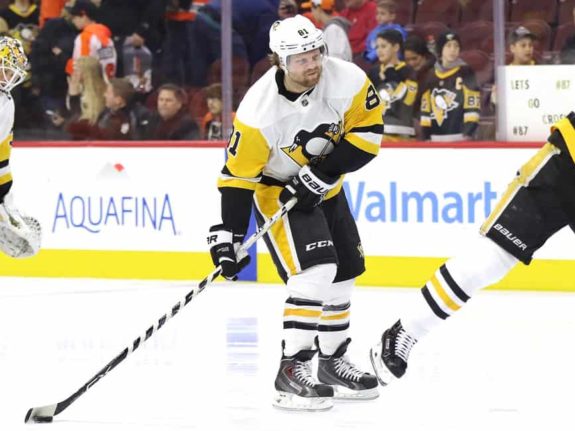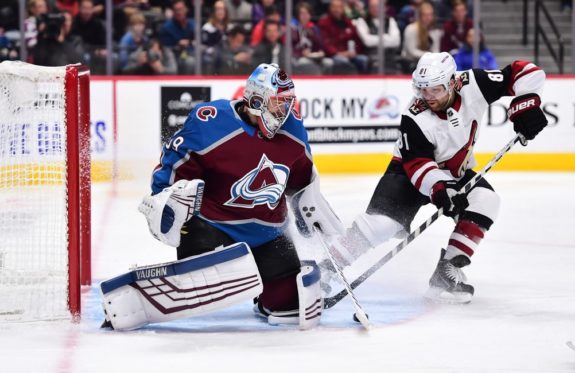In an effort to break their seven-season playoff drought, the Arizona Coyotes made a strong offseason push to improve the roster. After scoring 86 points during the 2018-19 season (the team’s highest since the 2013-14 campaign), the Coyotes acquired Phil Kessel and Carl Soderberg via trades in June. While they’re off to a 4-2-1 start (also the best since 2013-14), the Coyotes need more out of Kessel and the top line.
Kessel has just two goals and four points through Arizona’s first seven games and his two goals came in his sixth game. His linemates, Derek Stepan and Clayton Keller, have four and six points, respectively. These aren’t just random linemates; Stepan is a consistent 50-point scorer and Keller received a huge eight-year, $57.2-million contract extension this offseason. Combine that with the big trade to acquire Kessel and the trio has certainly been disappointing.
Why Has Kessel Struggled Out of the Gate?
Of Kessel’s four points, only one assist has come during five-on-five play; his other assist and both goals were during the man advantage. During his four-year stint with the Pittsburgh Penguins, 74 of his 110 goals and 104 of his 193 assists came at even strength. He’s always been a solid power play contributor, but without the five-on-five scoring, the Coyotes’ offense is going to continue struggling.
Kessel has always been a polarizing figure in the NHL. He spent years of his prime wasting away on a bad Toronto Maple Leafs team and was often the scapegoat, taking all the blame for being one of few good players on a roster void of talent and his departure was even celebrated by some media members. The right-handed sniper flipped the narrative when he won back-to-back Stanley Cups in his first two seasons with the Penguins. Then, despite scoring over 80 points for the second straight season, Kessel was shipped out of Pittsburgh after clashing with linemate Evgeni Malkin for most of the season.

It’s no secret that Kessel is temperamental. In fact, it’s why the Coyotes made so much sense for him this offseason. Head coach Rick Tocchet was an assistant coach for the Penguins during both of those Stanley Cup runs and the two formed a very close bond. Naturally, Tocchet was excited about the idea of a reunion with his former winger:
“Phil’s a great person and a generous guy,” Tocchet said. “His teammates love him. You know, not everybody is the same. To win a Stanley Cup, you need different personalities. I’m not sure you can win with all the same personalities. (Phil) had a personality in the dressing room that was infectious to (Sidney) Crosby, (Kris) Letang, (Evgeni) Malkin, all those guys.
(from “Coyotes’ Tocchet: ‘The young guys are going to like’ playing with Phil Kessel” AZ Central – 7/1/19
“Nobody is the same and Phil has a personality of his own. He marches to his own drum like a lot of different guys. It’s just more publicized being in Toronto and the trade and stuff.”
So, why has Kessel’s production dropped off to start the season? He’s back with his coach that he has a very close bond with and the Coyotes have been decent overall to start the season. Is this simply an adjustment period or should Tocchet start thinking about new linemates for Kessel?
Is Kessel Due for an Offensive Breakout?
Despite the lack of actual goal scoring, the underlying numbers for Kessel and the top line are very promising. His 57.6 Corsi percentage is by far the best of his career, surpassing his 2015-16 career high by nearly four full percentage points. The top line of Kessel/Stepan/Keller has recorded an insane 60.5 Corsi percentage when on the ice together this season. Over 75 percent of Kessel’s even-strength time has come next to those two.

All these numbers point to the 32-year-old sniper breaking out of the funk and starting to produce on offense. The current issue might be that Kessel just needs to do more. Despite his top-line role, he’s seeing just 17:46 of ice time per game, including 13:22 during five-on-five play; both of those are his lowest averages since the 2008-09 season. For reference, the University of Minnesota product averaged over 18:40 of ice time on the Penguins’ second line during his 92-point performance two seasons ago.
Kessel has also recorded just 20 shots on goal through seven games. His 215 shots last season were the fewest he’s put on net in a full season since the 2007-08 campaign. Kessel’s current pace would put him at roughly 234 shots; in his 12 previous seasons (excluding the lockout-shortened 2012-13 campaign), he averages 258 shots per season. As a career 11% shooter, he has the ability to drive this Arizona offense but he needs to be more active in the offensive zone.
Kessel’s advanced numbers are promising, but until those figures actually impact his goal-scoring abilities, the Coyotes offense won’t go very far. They’ve benefited from terrific netminding by Darcy Kuemper and Antti Raanta but, in a tough Pacific division, they won’t survive the playoff race with a sputtering offense. Arizona needs its star winger to get the puck on net more often and things should start working in Kessel’s favor.